Ask AI on The Internet
Question: Insert a table and place the following curriculum implications (numbered 1 – 10 below) for teachers and learners under the correct approach, namely behavioural, experiential, technological, naturalistic, humanistic and OBE: For example: APPROACH CURRICULUM IMPLICATION Academic Curriculum development is a systematic process directed by academic rationality and theoretical logic. 1. Teachers must perceive learners as cognitively functioning individuals within a social context. 2. Assessment is continuous, based on a variety of techniques. 3. Self-directed, unstructured and personalised instruction programmes that are “self-paced” are used. 4. The same curriculum elements of the academic, experience-based and technological approaches can be used. 5. Teachers become reflective practitioners with seven roles to fulfil. 6. Informal and hidden curriculum is also important, not only the formal and planned curriculum. 7. There is ongoing give and take within specific interest groups and viewpoints, negotiation and curriculum consensus. 8. There is stress on teachers and their cooperative curriculum decisions. 9. Needs assessment is the point of commencement. 10. Permission is given for more teacher input in curriculum decisions. QUESTION 2 Read through the following statements or scenarios and write down which teaching strategy will be the most effective: 2.1 Learners need to develop a strong base of declarative knowledge to synthesise their knowledge into an appropriate model and recognise common solution strategies. 2.2 It is two weeks before the election and you want the learners, who are 18 and who will vote for the first time, to understand exactly how a polling station functions. 2.3 The teacher states a problem and ALL the learners in the class participate. They have to find a solution. 2.4 As a teacher, you guide learners to construct new meaning and knowledge based on existing knowledge. 2.5 The teacher and learners took turns leading small-group discussions based on a reading. 2.6 The class is divided into small groups that must prepare and present a topic that is unfamiliar to them. The teacher will provide support. CUS3701 ASSESSMENT 02/2024 2.7 As a Mathematics teacher, your main focus is to listen to the learners' mathematical thinking and use it as a basis for instruction. 2.8 You want to encourage your learners to be open-minded and allow them to develop self-confidence when reasoning. 2.9 Many aspects can facilitate the learning process, including books, media or objects. But, most importantly, technology enables communication among learners, between learner and teacher, or through automatic feedback. 2.10 Asking the learners randomly questions keep everyone on their toes because no one knows who is going to be asked next.
### Approaches and Curriculum Implications | APPROACH | CURRICULUM IMPLICATION | |------------------|-------------------------------------------------------------| | Humanistic | 1. Teachers must perceive learners as cognitively functioning individuals within a social context. | | OBE | 2. Assessment is continuous, based on a variety of techniques. | | Humanistic | 3. Self-directed, unstructured, and personalized instruction programs that are “self-paced” are used. | | Behavioural | 4. The same curriculum elements of the academic, experience-based, and technological approaches can be used. | | Experiential | 5. Teachers become reflective practitioners with seven roles to fulfil. | | Naturalistic | 6. Informal and hidden curriculum is also important, not only the formal and planned curriculum. | | Technological | 7. There is ongoing give and take within specific interest groups and viewpoints, negotiation and curriculum consensus. | | Technological | 8. There is stress on teachers and their cooperative curriculum decisions. | | OBE | 9. Needs assessment is the point of commencement. | | Naturalistic | 10. Permission is given for more teacher input in curriculum decisions. | ### Teaching Strategies | Scenario | Teaching Strategy | |------------------------------------------------------------------------------------|------------------------------------| | 2.1 Learners need to develop a strong base of declarative knowledge to synthesize their knowledge into an appropriate model and recognize common solution strategies. | Direct Instruction | | 2.2 It is two weeks before the election and you want the learners, who are 18 and who will vote for the first time, to understand exactly how a polling station functions. | Experiential Learning | | 2.3 The teacher states a problem and ALL the learners in the class participate. They have to find a solution. | Problem-Based Learning | | 2.4 As a teacher, you guide learners to construct new meaning and knowledge based on existing knowledge. | Constructivist Teaching | | 2.5 The teacher and learners took turns leading small-group discussions based on a reading. | Cooperative Learning | | 2.6 The class is divided into small groups that must prepare and present a topic that is unfamiliar to them. The teacher will provide support. | Collaborative Learning | | 2.7 As a Mathematics teacher, your main focus is to listen to the learners' mathematical thinking and use it as a basis for instruction. | Inquiry-Based Learning | | 2.8 You want to encourage your learners to be open-minded and allow them to develop self-confidence when reasoning. | Socratic Method | | 2.9 Many aspects can facilitate the learning process, including books, media or objects. But, most importantly, technology enables communication among learners, between learner and teacher, or through automatic feedback. | Blended Learning | | 2.10 Asking the learners randomly questions keep everyone on their toes because no one knows who is going to be asked next. | Active Learning |
Think your answer is better than the AI's? Post it below.
Other Most Relevant Posts:
 ### 1
1. Inclusive Education
2. Transformative Teacher
3. Special School
4. Barriers to Learning
5. Social Isolation
### 2
1. Assessing Individual Needs
2. Promoting Collaborative Learning
3.
### 1
1. Inclusive Education
2. Transformative Teacher
3. Special School
4. Barriers to Learning
5. Social Isolation
### 2
1. Assessing Individual Needs
2. Promoting Collaborative Learning
3.
Question Tags
If you want your question answered by an AI, click here.






Post your own comment: